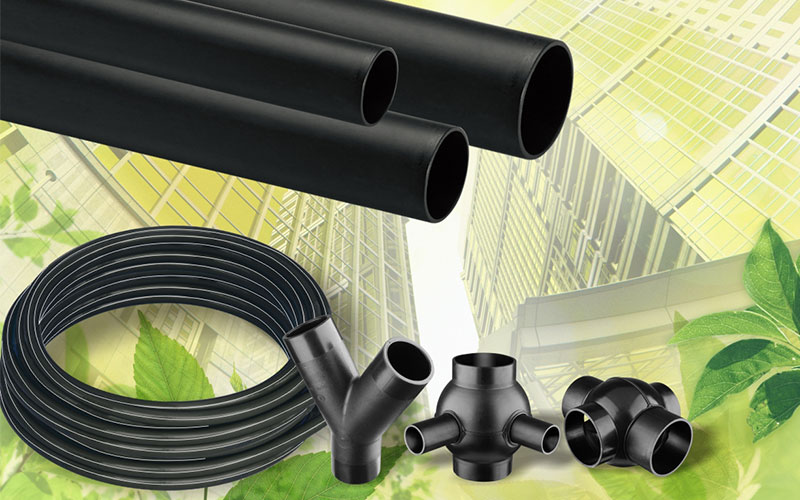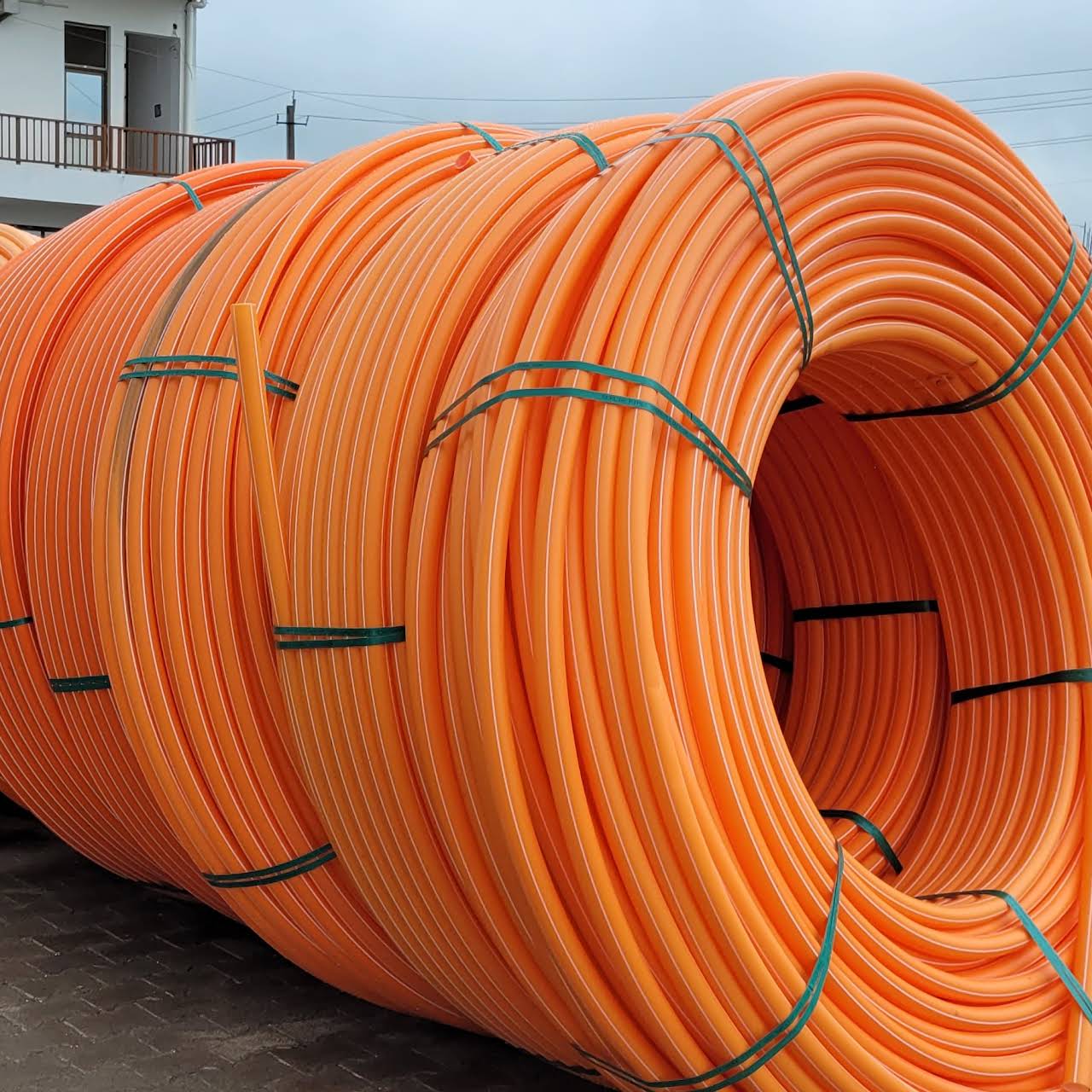Strengths of Choosing custom hdpe pipe manufacturing Midland TX for Specialized Projects
Wiki Article
Explore the Manufacturing Refine Behind High-Quality HDPE Pipe and Its Applications
The manufacturing process of premium HDPE pipes is elaborate and systematic. It begins with the selection of raw materials that improve performance. Following this, ethylene goes through polymerization to develop material, which is after that formed via extrusion. Quality control is extremely important, guaranteeing that the final item satisfies stringent criteria. The journey of HDPE pipelines does not finish with production. Their applications across various markets disclose a more comprehensive significance worth taking a look at.Comprehending HDPE: Qualities and Advantages

High-density polyethylene (HDPE) is a flexible polycarbonate known for its toughness and resistance to various environmental factors. This product shows superb tensile toughness, making it ideal for requiring applications. Its low-density structure adds to a light-weight product, assisting in simplicity of managing and installment. HDPE likewise showcases amazing resistance to chemicals, which lessens destruction when exposed to harsh materials.
The product's reduced dampness absorption even more boosts its durability, making it ideal for use in pipes and tank. In addition, HDPE is immune to ultraviolet (UV) radiation, ensuring that items maintain their honesty also when subjected to sunlight. Its versatility permits for the production of elaborate forms without compromising stamina. The green nature of HDPE, commonly derived from recycled materials, includes in its charm, advertising sustainable methods in production. Overall, these homes and advantages make HDPE a favored selection for numerous commercial and customer applications.
Resources Choice for HDPE Production
The selection of resources for HDPE manufacturing is vital to validate the final product satisfies the preferred requirements and quality requirements. High-density polyethylene (HDPE) is largely created from polymerized ethylene, originated from fossil fuels such as natural gas or petroleum. The high quality of these feedstocks significantly influences the mechanical and thermal buildings of the final HDPE.Ingredients also play a significant duty in enhancing HDPE's efficiency, including antioxidants, UV stabilizers, and colorants, which enhance sturdiness and resistance to ecological elements. The selection process should take into consideration not only the chemical structure of the raw materials however likewise their handling features to assure reliable production.
The sourcing of raw products need to focus on sustainability and conformity with environmental policies, as accountable methods are critical in today's market. Ultimately, mindful raw product selection lays the foundation for generating premium HDPE pipelines appropriate for varied applications.
The Extrusion Refine: Shaping HDPE Pipeline
The extrusion procedure plays an important role in shaping HDPE pipes, beginning with meticulous product preparation methods that ensure perfect flow and consistency. Similarly vital is the style of the die, which directly affects the last measurements and surface area top quality of the pipeline. With each other, these elements add substantially to the performance and high quality of HDPE pipe manufacturing.Product Preparation Methods
Efficient manufacturing of HDPE pipes starts with precise product prep work methods, specifically the extrusion procedure. During this phase, high-density polyethylene material is initial dried out to remove dampness, making sure ideal circulation qualities. The material is after that fed into the extruder, where it undertakes home heating and melting, changing into a thick state. This heating procedure is carefully controlled to preserve the material's stability and performance. The liquified HDPE is forced via a die, forming it into a continual pipeline kind. Proper temperature administration during extrusion is vital, as it straight influences the material's residential properties and the end product top quality. When formed, the HDPE pipeline is cooled and reduced to defined lengths, all set for subsequent handling and applications.Die Style Relevance
Precision in die design plays an important function in the extrusion procedure of HDPE pipes. The die acts as the final shaping device, straight affecting the pipe's measurements, wall surface thickness, and surface coating. A well-designed die assurances consistent material circulation, minimizing flaws such as irregularities and vulnerable points. The geometry of the die have to be optimized to suit the particular residential or commercial properties of HDPE, including its thickness and thermal actions during extrusion. Additionally, the cooling price of the product as it goes through the die can substantially affect the pipe's structural integrity. Spending in sophisticated die innovation is essential for manufacturers aiming to create high-grade HDPE pipelines that fulfill industry criteria and customer assumptions.Top Quality Control Measures in HDPE Manufacturing
Although various factors affect the top quality of HDPE pipeline manufacturing, efficient top quality control steps are important to guarantee consistency and reliability in the final product. Secret high quality control methods consist of strenuous material examination, verifying that the raw polyethylene fulfills well-known standards for pureness and thickness. During the extrusion process, criteria such as temperature level, stress, and cooling time are very closely checked Click Here to keep dimensional precision and architectural honestyOn top of that, post-production screening is important; makers commonly perform hydrostatic tests to evaluate the pipeline's toughness and resistance to stress. Aesthetic evaluations for surface defects further enhance quality guarantee. Qualification from pertinent requirements organizations, like ASTM or ISO, offers an extra layer of reliability. By carrying out these extensive quality assurance procedures, producers can lessen issues, improve efficiency, and ensure that the HDPE pipelines meet the particular demands of numerous applications, eventually causing consumer satisfaction and count on in the item.
Applications of HDPE Pipe Across Industries
HDPE pipelines are used across numerous sectors as a result of their durability and adaptability. In water circulation systems, they assure effective delivery, while in wastewater monitoring, they provide dependable options for waste transportation. In addition, farming irrigation networks gain from HDPE's resistance to corrosion and flexibility, making it an optimal option for modern-day farming methods.
Water Circulation Systems
A substantial variety of industries count on high-density polyethylene (HDPE) pipes for effective water distribution systems. Known for their longevity and resistance to deterioration, HDPE pipelines are extensively utilized in municipal water networks, agricultural irrigation, and industrial applications. Their light-weight nature promotes easy handling and setup, reducing labor expenses and time. Furthermore, HDPE pipelines can accommodate various stress degrees, making them ideal for both low and high-pressure systems. Pipe Supplier American Plastics Midland. The flexibility of the material permits smooth assimilation into existing infrastructure, minimizing the need for considerable excavation. HDPE's resistance to chemical leaching warranties that the water delivered remains secure and tidy, making it a suitable selection for keeping the top quality of drinkable water across numerous fields.Wastewater Administration Solutions
Reliable water circulation systems likewise lead the way for cutting-edge wastewater management options, where high-density polyethylene (HDPE) pipes play a substantial function. Prominent for their sturdiness and resistance to rust, HDPE pipes are excellent for delivering wastewater in numerous settings. Their versatility permits very easy installation in complex settings, minimizing the demand for considerable excavation. Additionally, HDPE's smooth indoor surface minimizes friction, enhancing circulation prices and effectiveness. These pipes are additionally immune to chemical leaching, making certain that impurities do not jeopardize the surrounding atmosphere. Industries, communities, and treatment centers increasingly count on HDPE pipelines for their reliability and durability, making them a recommended selection for modern wastewater administration systems. This versatility highlights the essential value of HDPE pipelines throughout many applications.Agricultural Irrigation Networks
Agricultural irrigation networks benefit considerably from using high-density polyethylene (HDPE) pipelines, which supply effective and reliable water distribution to plants. HDPE pipes are lightweight, making them simple to move and install, while their flexibility enables numerous configurations in varied surfaces. These pipes show exceptional resistance to rust, chemicals, and UV radiation, making sure sturdiness in rough farming atmospheres. In addition, their smooth interior surface reduces rubbing loss, maximizing water flow and lowering energy expenses related to pumping. The longevity of HDPE pipelines, usually going beyond half a century, adds to decrease maintenance and replacement expenses. Farmers significantly depend on HDPE pipes to enhance irrigation efficiency and promote lasting agricultural techniques, eventually leading to boosted plant yields and source conservation.
Future Patterns in HDPE Pipe Innovation
As the demand for lasting and reliable framework grows, advancements in HDPE pipe innovation are poised to change numerous industries. Emerging fads include the integration of wise find this technologies, such as sensing units and IoT capacities, which facilitate real-time tracking of pipe problems, minimizing maintenance expenses and preventing leaks. Furthermore, the growth of innovative manufacturing methods, such as 3D printing, is allowing the production of complicated, personalized pipeline designs that satisfy details task demands.In addition, the concentrate on recycling and round economic climate methods is driving the technology of HDPE pipes made from recycled materials, enhancing sustainability. Enhanced jointing techniques, such as electro-fusion and mechanical fittings, are additionally enhancing installation effectiveness and dependability. The expanding focus on ecological guidelines is pressing suppliers to take on greener manufacturing procedures, ensuring that HDPE pipes not only fulfill industry requirements but likewise cultivate an even more lasting future for framework development.
Regularly Asked Questions
How Does HDPE Contrast to Other Plastic Materials?
HDPE outmatches lots of various other plastic products concerning durability, chemical resistance, and flexibility. Its low density and high tensile stamina make it optimal for different applications, typically exceeding choices in both performance and longevity.What Are the Environmental Effects of HDPE Manufacturing?
The environmental influences of HDPE production consist of greenhouse gas exhausts, energy intake, and prospective pollution from producing procedures. Furthermore, inappropriate disposal can result in soil and water contamination, increasing concerns regarding lasting environmental effects.Can HDPE Water Lines Be Recycled?
Yes, HDPE pipes can be reused. Numerous centers accept utilized HDPE for processing, transforming it right into pex plumbing fittings new products. This reusing adds to sustainability efforts, reducing plastic waste while preserving resources and power in the production cycle.What Is the Life-span of HDPE Water Lines?

How Do Temperature Variations Influence HDPE Pipeline Performance?
Temperature variations substantially impact HDPE pipe efficiency, influencing flexibility and toughness. High temperatures can bring about softening, while reduced temperature levels might trigger brittleness, ultimately influencing the pipe's resilience and suitability for different applications in varied atmospheres.Report this wiki page